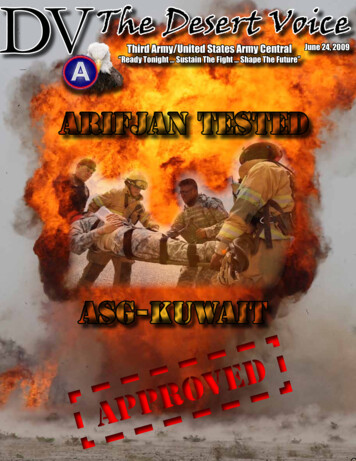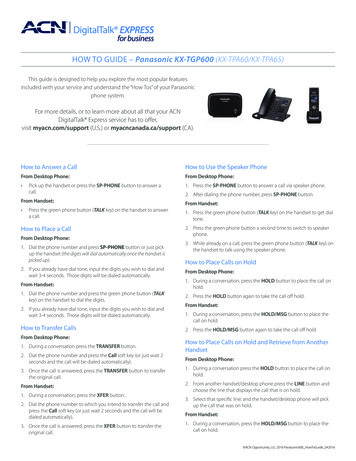
Transcription
DVThe Desert VoiceThird Army/United States Army CentralJune 24, 2009“Ready Tonight . Sustain The Fight . Shape The Future”Arifjan testedASG-KUWAITRPAPDEOV
DVTable of ContentsPage 4Soldiers sweat it outin “Biggest Loser”contestPage 5Distribution Depotwelcomes its newcommanderPage 8Seabees get SMARTwith new equipmentSuicide PreventionArecent Army-wide “stand down” for suicide-prevention training willbe followed by chain teaching that must be completed by July 15,2009. The centerpiece of the recent stand-down training was an interactivevideo called “Beyond the Front.” Suicide-prevention tools can be foundat the U.S. Army Center for Health Promotion and Preventive Medicine’sSuicide Prevention webpage and at the Army G-1 Commander Toolkitwebsite.SCommander’s Tool Kituicide prevention, like all leadership challenges, is a Commander’sprogram and every leader’s responsibility at all levels. The successof the Army Suicide Prevention Program rests upon proactive, caring andcourageous people who recognize the imminent danger and then takeimmediate action to save a life. Active engagement of everyone can helpto minimize the risk of suicide within the Army to stop this tragic andunnecessary loss of human life. Suicide prevention is everybody’s businessin The Army.The Commander’s Tool Kit is designed to assist Leaders at all levelsas they implement their Suicide Prevention Program. This Took Kit wasdeveloped so that leaders can incorporate these resources into existingtraining or create new training. However, this Tool Kit is not meant forleaders only, all Soldiers are encouraged to use the materials.On the coverPersonnel in 45th Fires Brigade,PMO, Fire department, 336thEOD and 437th Medical Companyparticpate in a Force protectionexercise, June 12. For the full storysee page 6. (Photo by Staff Sgt.Anthony Taylor)Contact usComments, questions, suggestions story ideas? Call the DesertVoice editor at 430-6334 or e-mailat ce2Volume 30, Issue 49The Desert Voice is an authorized publication formembers of the Department of Defense. Contentsof the Desert Voice are not necessarily the officialviews of, or endorsed by, the U.S. Governmentor Department of the Army. The editorial contentof this publication is the responsibility of the U.S.Army Central Public Affairs Office. This magazineis published by Al-Qabandi United, a private firm,which is not affiliated with USARCENT. All copy willbe edited. The Desert Voice is produced weekly bythe 20th Public Affairs Detachment.USARCENT Commanding GeneralLt. Gen. William G. WebsterUSARCENT Command Sgt. Maj.Command Sgt. Maj. John D. FourhmanUSARCENT Public Affairs OfficerCol. Gerald O’HaraUSARCENT Public Affairs Sgt. Maj.Sgt. Maj. Brian ThomasUSARCENT Deputy PAO (FWD)Lt. Col. Martha BrooksFind us online at www.arcent.army.mil.The Desert Voice June 24, 2009USARCENT20th Public Affairs Detachment CommanderMaj. Jason Shropshire20th Public Affairs Detachment SergeantStaff Sgt. Jarod Perkioniemi20th Public Affairs DetachmentSgt. Brooks FletcherSpc. Elayseah Woodard-HintonPfc. Howard KetterPfc. Alicia Torbushhttp://www.youtube.com/user/dvidshub?blend 2&ob 1
Have A Healthy Week!Mcalories, high in fiber; and packed with nutrition.any people have health or fitness goals theyThey are your best friend for losing weight andhope to achieve during deployment. Don’tknow where to start? Here are 5 simple ways to befighting chronic disease. Choose vegetables thatare rich in color like beets and carrots. Fill at leasthealthier this week.Don’t skip breakfast. Eating breakfast gets yourhalf of your plate with vegetables at lunch anddinner.metabolism going in the morning, refuels yourGet more sleep. Adults need 7-8 hours ofmuscles after a morning workout and helps preventCapt. Kate Schrumm R.D.overeating later in the day. Breakfast is asleep per night. According to theU.S. Army Central Surgeon’s OfficeNational Institutes of Health, lack ofgreat time to increase your whole grain(oatmeal, cereal), fruit and low-fat dairy (milk, yogurt)sleep not only makes us tired, moody and less focusedduring the day, but can increase our risk of heart disease,intake.Do more cardio. Cardiovascular exercise is beneficial for hypertension, diabetes and obesity. Hormone changes thatoccur with lack of sleep weaken our immune system andweight loss, weight maintenance; and decreases your riskmake us crave sweets and carbohydrates. Make an effort tofor cardiovascular disease, hypertension, diabetes, cancer,get to bed earlier this week.depression and more. The current recommendation is forStop drinking your calories. Check the labels of whatat least 30 minutes of cardiovascular exercise on mostyou are drinking. Many people consume 500-600 calories/days of the week. This includes jogging, walking, biking,day just from liquids like Gatorade, juices, sodas, coffeeswimming, racquetball, tennis, volleyball, rowing, usingand energy drinks. Eating your calories is a better way tothe elliptical machine and many more activities. Mix upget adequate fiber and a larger variety of nutrients. Chooseyour routine to keep it interesting, but increase your timeskim milk or water with some added calorie-free flavor likespent exercising if at all possible.Crystal Light or electrolyte packets over calorie dense, lowEat more vegetables. Most people do not eat thenutrient beverages.recommended 3-5 servings per day. Vegetables are low inLift yourself with knowledge. Regardless if you arelifting folders of the DA Form 31 or are carryingpatients into the triage room; knowing the properlifting and carrying procedures are vital.Many people may believe their instinctualmovement will compensate for any probableinjury, but lifting and carrying injuriesaccount for a large percentage of nonfatalwork cases.The Bureau of Labor Statistics, U.S.Department Labor indicated the part ofthe body most often affected by workinjuries was the trunk (including theshoulder and back) accounting for 33percent of all injuries and illnesses from2006 to 2007.Consequently, utilizing the propertechniques will reduce your opportunity tobecome one of these statistics.Is it spring, sprang or sprung? When one thinks ofoccupational and recreational injuries, one may think offractures, lacerations or even bruises or burns.However, these overt injuries are not the onlyinjuries incurred during work and play.The Bureau of Labor Statistics, U.S. DepartmentLabor indicated sprains and strains were the mostfrequent nature of injuries and illnesses; however,smashed fingers, eye injuries, head injuries and evenfatalities can result from improper lifting and carryingprocedures.Although the number of cases had decreased 5percent from 2006, compared to a 2 percent declinefor all injuries, there are many incidentsthat can be prevented if one improves theirtechnique in accordance with their physicalstamina and the environmental constraints.Therefore, practicing the proper liftingand carrying techniques are essential for thephysical longevity of your most valuable tool;your body.USARCENTJune 24, 2009 The Desert VoiceU.S. Army CentralSafe Carrying and Lifting3
Task Force AVCRAD holds “Biggest Loser” contestdeployment,some contestantsare alreadystarting to seeresults.“[Theweight’s] comingdown and I feelbetter, but thereality of it is, it’sharder than it hasever been in mylifetime for meto drop weightsimply because ofmy metabolism,”“Biggest Loser” contestant Pfc. Jaime Lopez uses a curl said Marquez.machine during his workout.Cabrera andArticle and photos bySgt. Maj. Carlos Fernandez, nonPfc. Alicia C. Torbushcommissioned officer in charge,20th Public Affairs Detachment“It’s a personal goal to workthis year to lose weight, gethealthier and learn to eat right.”Staff Sgt. Lashandra Washington1106 th Aviation Classification and Repair DepotCamp Arifjan, KuwaitTheater Aviation MaintenanceProgram, Iraq have some incentivesfor the Soldiers who lose the mostweight during the contest.“It’s a little bit easier to meet thegoal when you have a group of peoplerather than going in by yourself,” saidStaff Sgt. Freddy Cortez safety NCO.The contest will end a February2010 when all of the contestants willbe weighed and measured and havetheir BMI taken again.Camp Arifjan“B4asically what’s happeninghere is a change of lifestyle,”said Staff Sgt. Steven Marquez, unitenvironmental officer, 1106th AviationClassification and Repair Depot.Task Force AVCRAD is sponsoringa “Biggest Loser” TV show-stylechallenge to encourage Soldiers tomaintain Army physical fitness andheight and weight standards.“Trying to keep Soldiers fit is achallenge,” said Command Sgt. Maj.Ronald Cabrera, TF AVCRAD. “Wetried to think of something creative togive them something to strive for.”Cabrera proposed the idea duringpre-deployment training and kickedoff the competition a few weeks intothe deployment by recording thestart height, weight and body massindex of all the contestants. There are15 Soldiers from the TF AVCRADparticipating in the competition in bothKuwait and Iraq.“The pounds start to creep up onyou faster than you realize and oneday you get on the scale and you’re30 pounds heavier,” said Staff Sgt.Lashandra Washington. “For me, it’s apersonal goal to work this year to loseweight, get healthier and learn to eatright.”Less than two months into theThe Desert Voice June 24, 2009Lopez warms up as part of his exercise routine that he started to lose weight duringthe “Biggest Loser” contest.USARCENT
DDDK welcomes new commanderMarine Brig. Gen. Peter J. Talleri, commander, Defense Distribution Command, passes the guidon to Army Col. Vernon L. Beatty,incoming commander, Defense Distribution Depot, Kuwait, after taking it from outgoing commander, Army Col. Clayton T.Newton. The passing of the guidon symbolizes the transfer of authority from one leader to the next.The Defense Distribution Depot Kuwait welcomed anew commander at a change of command ceremonythat was held at DDDK, June 1.Army Col. Vernon L. Beatty, Jr. assumed command ofDDDK from Army Col. Clayton T. Newton who took overcommand in July 2007.“Col. Beatty is qualified in both service and educationto assume this command,” said Marine Brig. Gen. Peter J.Talleri, commander, Defense Distribution Command. “Hehas a strong background in logistics and history of servicein his family.”Beatty is assuming command of DDDK after servingas director of the Army Initiatives Group, LogisticsBranch, Headquarters Department of the Army G4. Hehas also served as commander of the 710th Main SupportBattalion, 10th Mountain Division; 123rd Main SupportBattalion; aide-de-camp to the commander and chief ofthe Emergency Support Operations Center at the DefenseLogistics Agency Defense Supply Center after a year intraining with Wal-Mart Stores, Inc. as part of the Trainingwith Industry program. Beatty enlisted in the Army as acombat engineer in 1981.He attended Ohio State University and received hisMaster’s degree in business administration fromCentral Michigan University.His awards and decorations include the BronzeStar, Afghanistan Campaign Medal, SouthwestAsia Service Medal with two Bronze Stars, KuwaitiLiberation Medal, Kosovo Liberation Medal NATOMedal with two Bronze Stars, a Ranger Tab, SeniorParachutists Badge, Rigger Badge, and Air AssaultBadge.DDDK was established in 2004 and is theDefense Distribution Center’s only facility inSouthwest Asia. According to material publishedby DDDK, the primary mission of DDDK is toa forward stock positioning support and quickdistribution of supplies to forces in the area ofoperations.The ceremony ended with the symbolic passing of theguidon and guests were invited to say their goodbyes tothe outgoing commander and bid welcome to the newcommander.“Col. Beatty is qualified in both service and educationto assume this command. He has a strong backgroundin logistics and history of service in his family.”USARCENTMarine Brig. Peter J. TalleriCommanderDefense Distribution CenterJune 24, 2009 The Desert VoiceKuwaitArticle and photo byPfc. Alicia C. Torbush20th Public Affairs Detachment5
FORCE PROTECTIONEXERCISE JUNE 2009Article byPfc. Howard Ketter20th Public Affairs DetachmentSCamp Arifjanoldiers alongside the Provost Marshall Office,Combat Support Associates personnel, firefightersand Explosive Ordinance Disposal conducted aForce protection exercise at Camp Arifjan, Kuwait, June12.The Area Support Group-Kuwait Force protection officeput together a scenario that took place in Zone 6, involvingthe 45th Fires Brigade, PMO, Fire department, 336th EODdetachment and medics from the 437th Medical Company.“The exercise was rehearsed and well planned out,”said Lt. Col. Robert E. Sowards, officer in charge ofthe exercise, ASG-KU Force Protection. “We conductquarterly force protection exercises on Camp Arifjan.”The exercise kicked off at approximately 8:30 a.m. witha large explosion.“A [vehicle borne improvised explosive device]attacked and destroyed ECP 2, which required re-routingof traffic and treatment of 12 to 18 casualties,” saidSowards. “The tower also spotted vehicles outside theperimeter.”Soldiers from Headquarters and Headquarters Battery,45th Fires Brigade set up traffic control points to directtraffic flow in and out of Zone 6. They also had Soldiersoverseeing the exercise as observer/controllers.“My main focus was to be sure that the Soldiers werehydrated and well taken care of,” said Sgt. Messiah L.Irizarry, HHB, 45th Fires Brigade, who was an O/C for theexercise. “Zone 6 responded with urgency and they wereall over it, the exercise went well.”Simultaneously, another scenario kicked into action.The Zone 6 dining facility was attacked by mortars.The Camp Arifjan kennel deployed 11 military workingdog teams out to investigate.“As soon as there is an incident like this, we send outdog teams to search for any secondary devices,” saidChief Petty Officer Brian H. Waters, kennel master, CampArifjan. “We also send them to other vital areas throughoutthe base to respond to incidents as needed.”Arifjan Firefighters alongside the 437th medicsassessed and evacuated several simulated casualties fromboth locations. The casualties, played by CSA securitypersonnel, had make-up and simulated injuries and bloodto make the exercise more realistic, giving the medics andfirefighters a variety of injuries to assess and treat. Theywere all moved to the Tactical Activity Center in Zone 6,which was staged as the casualty collection point for theexercise.“I appreciate the response of all the units on CampArifjan,” said Sowards. “The motivation of the Soldierswas good and we identified a lot of things we needed towork on, which was the intent of the exercise.”6The Desert Voice June 24, 2009USARCENT
Photos by Staff Sgt. Anthony L. TaylorCamp ArifjanSoldiers from the 437th Medical Company provide aid to a mock-casualty during a Force Protection excerse at Camp Arifjan,Kuwait, June 12. The exercise was to test the base’s response time to a mock-attack.USARCENTJune 24, 2009 The Desert Voice7
Naval Mobile Construction Battalion 1Article and photos byMC1 Nichoilas LingoNMCB 11 Public Affairs OfficeTSpainhe Seabees have long been established as thepremier construction force of the U.S. military.Their long-standing tradition of “We Build, WeFight” is instilled in each constructionman from the veryday they step into the world of the Seabees. Yet no warriorcan perform at their peak level without the proper tools.The Seabees have long awaited an update to their Tableof Allowance and that day has arrived for the ‘Bees ofNaval Mobile Construction Battalion 11.The discussion and planning stages have been in theworks for years for the development of the Scalable,Modular, Agile, Responsive TOA, or S.M.A.R.T.“The actual planning stages began several years ago, butthe actual packing of the materials and gear began back inJanuary for this set-up,” said Frisly G. Garcia, manager,22nd Naval Construction Regiment Non-CESE TOA.The new S.M.A.R.T. P-25 will provide a reducedfootprint and ease transport for equipment to forwarddeployed Naval Construction Force units.The current off-load of equipment in Rota, Spain, willprovide the re-established forward deployed location ofCamp Mitchell, Spain, the proper equipment needed tosupport missions in Europe and Africa Commands andanywhere else the Seabees may be called on to support.The new TOA is expected to make movement for theNaval Construction Force less strenuous for operational8planning.“Instead of planning every operation from ground zero,pulling from an entire TOA, we’re now able to pull fromone of the construction modules,” said Lt. Cmdr. JosephHarder, NMCB 11 Detachment Rota Officer in Charge,“From that sub-group of equipment we can decide what toscale down and what to scale up.”The new TOA’s improved module format vastlyincreases the speed and ease that smaller units can beoutfitted and geared-up for deployments.With the retrograde of the Seabees main body site fromCamp Arifjan, Kuwait and the return of the Seabees toCamp Mitchell, the timing for the off-load of the new TOAcame at an opportune time.Approximately 40 Seabees were flown in days beforethe off-load to ensure there were enough operators andmechanics on location to support the evolution. During thethree-day movement, 324 pieces of Civil Engineer SupportEquipment and 176 containers were off-loaded from theMobile Vessel Alliance New York.“It’s really great to see this equipment; it’s all newand it’s all modernized,” added Equipment OperatorConstructionman Christopher Ruel. “We’ve been doingthe best with what we have for years, now we’ll be able tomake things happen so much more efficiently. I’m reallyhappy to be moving this off the ships and putting it to gooduse.”“Across the board the new TOA is a lot moremodernized,” added Harder, “A lot of the equipment in thenew TOA is suited for the types of missions we’re involvedConstruction Mechanic 1st Class Jeremy Petroski ground guides a piece of Civil Engineer Support Equipment off of the MVAlliance New York. The new equipment will help re-establish Camp Mitchell as a main body site for forward deployed Seabeeunits and will better outfit NCF units for deployment to EUCOM and AFRICOM.The Desert Voice June 24, 2009USARCENT
11 offload new TOASeabees from Naval Mobile Construction Battalion 11 loada piece of Civil Engineer Support Equipment on a trailerfor transport to Camp Mitchell, Spain.USARCENTJune 24, 2009 The Desert VoiceSpainin, these upgrades allow us to use the right tools for the jobswe do.”The upgrades to the TOA provide better safety features,improved stability and operational capability as well assome comforts that were missing before, such asclimate control.“This is a big step forward for the entire NavalConstruction Force that all started with the basicneeds for our Seabees,” added Harder. “Thisis a tremendous financial investment and hugesuccess story for the NCF. It’s a big deal to bea part of this process and to be able to see allthis planning come to fruition.”The Seabees will have a fresh start in Spainwith a brand new set of tools at the ready,to continue to win the hearts and mindsand provide the best combat constructionsupport available.The Seabees of NMCB 11 are currentlydeployed to Horn of Africa, Afghanistan,Kuwait and Iraq in support of OperationsIraqi and Enduring Freedom.9
NEWS IN BRIEFPENTAGON RELEASES DETAILS OFHOMEOWNER ASSITANCE PROGRAMEXPANSIONUnited States of AmericaO10ne of the first acts of the 111th Congress wasthe passage of the American Recovery andReinvestment Act. Included in the legislation was 555 million in funding for a program to help militarypersonnel forced to sell their homes in the midst of thecurrent real estate crisis.The Pentagon recently released the much-anticipatedHomeowner Assistance Program expansion guidance.Here are the rules:Eligibility:Homeowners must have lost at least 10 percent betweenthe purchase price and sale price of the home, and thehome must be in an area that suffered at least a 10 percentdecline in housing prices.The home’s value must not exceed a cap thatranges between 417,000 and 729,750,depending on location.The move must be farther than 50 miles.Homeowners under PCS orders or affectedby base realignment and must have purchasedthe homes before July 1, 2006.Base Realignment and Closurehomeowners must sell their houses, onthe local market or to the government, bySept. 30, 2012.Reimbursement for losses:Wounded warriors, wounded defenseor Coast Guard civilians and survivingspouses would receive a cash payment for the differencebetween their home’s sale price and 95 percent of its priorfair-market value.Those in communities where it is proven that the marketdeclined because of a BRAC announcement would receive95 percent of the home’s prior fair-market value.Other BRAC and PCS homeowners would receive up to90 percent of the home’s prior fair-market value.Government purchase/mortgage payoff:The government will buy the home only if thehomeowner can’t sell it after 120 days on the market at aprice deemed appropriate by the Army Corps of Engineers.Wounded warriors, wounded defense and Coast Guardcivilians and surviving spouses unable to sell their homeswill be able to sell to the government for 90 percent of thehome’s prior fair-market value.For BRAC and PCS homeowners, the governmentwould pay 75 percent of the home’s prior fair-marketvalue.There are three HAP field offices. To find out whichservices your area and for more information, visit theirwebsite at http://hap.usace.army.mil.The Desert Voice June 24, 2009CEREMONY RECOGNIZES NCOS INCONGRESSssociation of the United States Army Presidentand Army retiree, Gen. Gordon R. Sullivan,attended a ceremony held at Fort Myer, Virginiathat recognized 10 members of the 111th Congress whohave served as NCOs.As part of the Army’s celebration of the Year of theNoncommissioned Officer, Secretary of the Army, PeteGeren; Army Chief of Staff, Gen. George W. CaseyJr.; and Sgt. Maj. of the Army Kenneth O. Preston paidtribute to the 10 representatives in attendance, as wellas four others not in attendance and three senators whoserved as NCOs.Each congressman was given a token of appreciationfrom Geren, as well as a coin from Preston.Preston thanked all the veterans in the audience.“Members of Congress who are here todaybegan a lifetime of service to our nation asnoncommissioned officers in the United StatesArmy,” Preston said. “As we celebrate2009 as the Year of the NCO, weall know that the noncommissionedofficer corps was not formedovernight . and our army today is thebest Army in the world because of thecompetence of these mid-level leaders.”To see detailed infomation about these andother former soldiers serving in Congress,visit the AUSA webpage, www.ausa.org. Clickon the Government Affairs link, then on “ArmyVeterans in Congress, 2009.UNIT HIGHLIGHTShe 14th Human Resources Sustainment Center,Operations and Planning section is responsible forthe train up and planning for approximately 107human resource units around theater and in the U.S.Their mission is to assist the HRSC director in theplanning, integration, coordination and synchronizationof all HRSC staff operations and integrate withTheater Sustainment Command staff elements inthe management of theater-wide Human Resourcesoperational requirements.The section, located in building 506, Camp Arifjan,conducts planning for the entire 14th HRSC and provideshuman resource related planning guidance for 1st TSC.The enlisted Soldiers in the unit have accomplishedputting together and organizing an exercise structuredaround HR duties in theater to train units coming intotheater.For more information on this section, they can befound under the staff sections link on the 1st TSC portal.Or you can contact them at 430-6618.ATUSARCENT
Just One Question .NATURALIZATIONCEREMONY“Good communication isimportant because it allowsthe chain of command to beaware of expectations andhelps missions run smoothly.”GM1 (SW) James WolfeSquad LeaderNAVELSG (Fwd) IndiaChicago, Ill.27 JUNE 2009Camp Arifjan“Proper communication savesthe lives of Soldiers if they arewilling to listen. “Zone 1 Chapel@ 0930Sgt. Jaswanti ChanderRedeployment NCOIC49th AG 90th HRCSacramento, Calif.“Communication is importantbecause it allows leaders tomake informed decisions andlets them help Soldiers beforea situation gets out of hand.”Maj. Theodore WestHHC CommanderU.S. ARCENTSan Jose, Calif.Sgt. David EddyAdministrative NCO, USARCENT SGSEddy saw ROTC Soldiersperform drills when hewas in sixth grade anddecided he wanted to jointhe Army. He finally joinedon June 2, 2005 as anInfantry Soldier. He wasstationed at Fort Drum,N.Y. and deployed toBagdad, Iraq. He decidedto PCS to Fort McPhersonto be closer to his hometown, Nashville, Tenn.Eddy wants to continuehis education and work inthe technology field afterhe retires from the Army.USARCENT“Knowing what is needed toaccomplish the mission.”Tech Sgt. Anthony KrebsVehicle Operator424th Medium Truck DetachmentLuray, Va.“You want to let everyoneknow what is going on asfar as health and safety areconcerned. Those are all theimportant factors.”Sgt. Josilyn HinesPostal Supervisor81st Military Mail TerminalPortsmouth, Va.June 24, 2009The Desert VoiceU.S. Army CentralNCO Spotlight:“Listen to your NCO leadersand never be afraid to askquestions.”Why is communication with yourchain of command important?11
Remembered Throughthe Bonds of ServiceArticle byPfc. Alicia Torbush20th Public Affairs DetachmentAyoung Soldier walks through the airport on his way home for his midtour rest and recuperation. He has spent the past several months patrolling the streets of Baghdad and is looking forward to spending the nextcouple of weeks with his family and being away from the turmoil of theseemingly endless deployment.As he mounts the escalator that will carry him upward to baggage claimand freedom, the top of an elderly man’s white hair comes into view. Thefurther the Soldier ascends, the more he can see of the older gentleman;and then the welcome home banner comes into view. The gentleman is wearinga shirt with the word “VETERAN” embroidered across the front and waving anAmerican flag to welcome troops coming home from war.Curious about the gentleman’s story, the young Soldier stops to ask whichwar the man had served.“I have served in them all,” replied the veteran. “I am a veteran of allwars. I fought in the battles that took place during the American Revolution to secure our country’s freedom in its infancy. I fought my brother inthe Civil War that split our nation. I served my country in the trenchesduring World War I and on the naval ships of World War II. I fought withmany brave men and women in Vietnam, Panama and Korea. I have faced the unseen enemy in the Middle East. I have stood beside the families of friends,brothers and sisters who paid the ultimate price for the freedoms that areso often taken for granted. I am a veteran. Just like you I have chosen toserve and represent the country that I love, so that others after me canenjoy the same freedoms that those before me fought and died to secure.Together we all form the bond that ensures the security of our country.Through the years we have all stood together to serve, to give our livesfor the country that has given so much to us. In each of us who chooses toserve, the spirits of those who paid the price for our freedom live on. Weare the living memorials of those who paid the price to keep this countrystrong.”As the young Soldier listened to the gentleman talk, he understood thathe was as much a part of the history of service as the present and the future. He realized that he represented all servicemembers from all times. Inthat moment, the young Soldier felt a kinship with the veteran who taughthim about the bonds that are forged throughout the battlefields of time.The pride and honor of service goes hand in hand with remembering thosewho have gone before and mentoring those who will follow.Through the bonds that service creates, we remember those who have servedand those who are serving. The remembrance is continuous in the heads thatbow in prayer over the loss of a brother or sister on the battlefield, inthe empty table in the chow hall for those fallen in combat and in theinner strength that each servicemember finds to “soldier on” despite thegrueling obstacles they face day-to-day.
Lopez warms up as part of his exercise routine that he started to lose weight during the “Biggest Loser” contest. “Biggest Loser” contestant Pfc. Jaime Lopez uses a curl machine during his workout. “B Staff Sgt. Lashandra Washington 1106 th Aviation Classification and Repair










